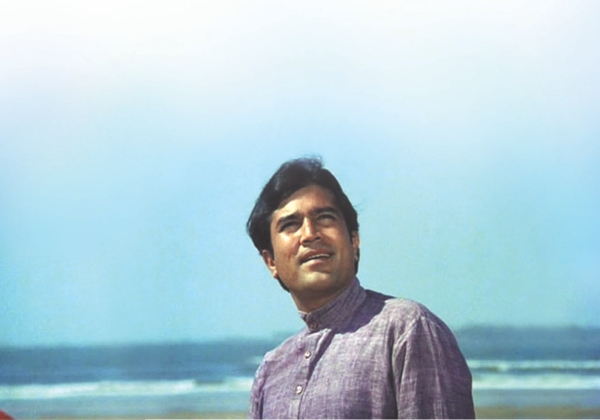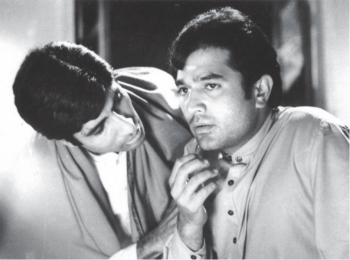| Home - Back Issues - The Team - Contact Us |
 |
| Volume 11 |Issue 30| July 27, 2012 | |
|
|
Musings
The Rise and Decline of Rajesh Khanna Syed Badrul Ahsan My Urdu-speaking friends, having travelled from Quetta to Delhi on holiday in February 1971, came back bubbling with excitement at the films they had seen there. They acquai-nted us with news of a ravishing new actress named Hema Malini and a romantic hero called Rajesh Khanna. That was the first time I had heard of Rajesh Khanna and it was not before some more time elapsed that I saw his images in a film magazine. Subsequently (and this was much later in the 1970s) opportunities arose for me to watch some of his films. There was Kati Patang that I remember all too well, especially for the songs. I have always wondered at this strange phenomenon about Indian films–that some films, be they good or bad, have sometimes enriched themselves with absolutely breathtaking music. Kati Patang was one such film. And the song which took hold of my imagination – and I sing it to this day – was the Kishore Kumar number pyar diwana hota hai mastana hota hai. Images of Rajesh Khanna going out on a limb to win the love of a perpetually, understandably sad Asha Parekh have kept coming back down the years. In a bigger sense, though, Khanna has always made me wonder. He was a wonderful actor where he should have been a great one. The fact that he was unable to scale those Olympian heights, for reasons which had to do with him and with the changing mindsets in the Indian film industry has forever been a soft pain somewhere deep in the consciousness. But while his run in the industry lasted, Khanna did make an impression, did convince people of the frothy romance in him. Film-goers were in a frenzy every time one of his films was released, to box office acclaim. He could not disappoint. And he didn't. My memories of Rajesh Khanna circle around the songs picturised on him. Recall that Kishore number, jeevan se bhari teri ankhen majboor karen jeene ke liye and you will recreate within you the pleasures of romance as it used to be. The song is but a symbol of undying love. A cool Khanna, master painter of romance, draws a demure, lovelorn Sharmila Tagore to him through his melody. You almost wish the role was yours rather than Khanna's. Or you imagine the woman in whose dark tresses your songs take on new meaning in the nocturnal hours, in whose dusky warmth you find meaning in life once more. Reflect on that all-time favourite song of millions – hai ye jo mohabbat hai ye un ka hai kaam – and chances are that you will sense that old throbbing of ancient love welling up somewhere deep inside you again.
That is how Rajesh Khanna the man on the big screen comes to you. His handsome features, his well-combed hair and his frolicsome movements around his leading ladies are a reminder of youth, every man's youth. Now move on to Rajesh Khanna as he was in real life, outside the films. His romance with the actress Anju Mahendru was long and intense, to a point where people in and outside the film industry talked about it in either fascination or disapproval. And then came time for Dimple Kapadia to step into Khanna's life. He simply ditched Mahendru and hitched himself to Kapadia. It is said that on the day he was to marry Kapadia, he made sure that the bridegroom's procession passed by Mahendru's residence. Sadistic pleasure was beginning to spell the end for him. He would make sure that Anju Mahendru never had any more chances in films. Arrogance, it was obvious, had wormed its way into Khanna's character. And every time an artiste tells himself he is way above the others in his thespian skills, he destroys himself a bit more. Rajesh Khanna was slicing away at himself bit by dangerous bit. His marriage with Dimple Kapadia went sour, compelling the couple to separate. And then he proceeded to have a good number of affairs, none of which gave him happiness. Affairs do not bring happiness. They are the portents of future darkness. Khanna was beginning to destroy himself in his battles with the dark. He was the Indian film industry's superstar, the very first in its history. And stardom went, in that clichéd manner of speaking, to his head. The decline had clearly set in. The decisive moment came with Anand. The audience sympathised with a cancer-ridden Rajesh Khanna in the story, but it also did not fail to notice the sparks in a yet to be famous Amitabh Bachchan. For the very first time in his career, Khanna had a rival, a probable future successor as superstar. In the end, it was Bachchan who won out. A better actor than Khanna in terms of versatility, Bachchan effectively spelt the end of Rajesh Khanna's grip on the film industry. It was time for Khanna to find a new career. And he did so, in the political arena. In 1991, as the candidate of the Congress, he missed winning a Lok Sabha seat to the BJP's LK Advani. Subsequently, though, once Advani had taken up another seat he had won, Khanna dived into a fresh election and won. The man who lost to him was his fellow actor Shatrugan Sinha. Khanna did not make any waves in the Lok Sabha. It was a waste of politics. For all his eccentricities, with all his inadequacies, Rajesh Khanna was our symbol of youth, our hold on romance. Women loved him as much as he loved being in love with them. He revelled in the presence of Sharmila Tagore, Mumtaz, Zeenat Aman, Asha Parekh and Tina Munim. And then he aged, not as gracefully as he should have. And yet he was Kaka, everyone's Kaka, for better or worse. Moving time has claimed him, in that certain grasping way that has left its claw marks on life.
The writer is Executive Editor, The Daily Star.
|
||||
|

